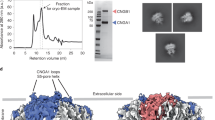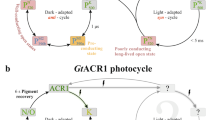Abstract
The surface membrane of retinal rod and cone outer segments contains a cation-selective conductance which is activated by 3′,5′-cyclic guanosine monophosphate (cGMP)1–4. Reduction of this conductance by a light-induced decrease in the cytoplasmic concentration of cGMP appears to generate the electrical response to light (reviewed in refs 5, 6), but little is known about the molecular nature of the conductance. The estimated unitary conductance is so small1,7–9 that ion transport might occur via either a carrier or a pore mechanism. Here we report recordings of cGMP-activated single-channel currents from excised rod outer segment patches bathed in solutions low in divalent cations. Two elementary conductances, of ∼24 and 8 pS, were observed. These conductances are too large to be accounted for by carrier transport, indicating that the cGMP-activated conductance consists of aqueous pores. The dependence of the channel activation on the concentration of cGMP suggests that opening of the pore is triggered by cooperative binding of at least three cGMP molecules.
This is a preview of subscription content, access via your institution
Access options
Subscribe to this journal
Receive 51 print issues and online access
$199.00 per year
only $3.90 per issue
Buy this article
- Purchase on SpringerLink
- Instant access to full article PDF
Prices may be subject to local taxes which are calculated during checkout
Similar content being viewed by others
References
Fesenko, E. E., Kolesnikov, S. S. & Lyubarsky, A. L. Nature 313, 310–313 (1985).
Nakatani, K. & Yau, K.-W. Biophys. J. 47, 365a (1985).
Yau, K.-W. & Nakatani, K. Nature 317, 252–255 (1985).
Haynes, L. & Yau, K.-W. Nature 317, 61–64 (1985).
Altman, J. Nature 313, 264–265 (1985).
Stryer, L. A. Rev. Neurosci. 9, 87–119 (1986).
Gray, P. & Attwell, D. Proc. R. Soc. B223, 379–388 (1985).
Bodia, R. D. & Detwiler, P. B. J. Physiol., Lond. 367, 183–216 (1985).
Zimmerman, A. L. & Baylor, D. A. Biophys. J. 47, a357 (1985).
Koch, K.-W. & Kaupp, U. B. J. biol. Chem. 260, 6788–6800 (1985).
Zimmerman, A. L., Yamanaka, G., Eckstein, F., Baylor, D. A. & Stryer, L. Proc. natn. Acad. Sci. U.S.A. 82, 8813–8817 (1985).
Hille, B. Ionic Channels of Excitable Membranes, 202 (Sinauer Associates, Sunderland, Massachusetts, 1984).
Yau, K.-W., McNaughton, P. A. & Hodgkin, A. L. Nature 292, 502–505 (1981).
Capovilla, M., Caretta, A., Cervetto, L. & Torre, V. J. Physiol., Lond. 343, 295–310 (1983).
Hodgkin, A. L., NcNaughton, P. A. & Nunn, B. J. J. Physiol., Lond. 358, 447–468 (1985).
Baylor, D. A., Lamb, T. D. & Yau, K.-W. J. Physiol., Lond. 288, 613–634 (1979).
Author information
Authors and Affiliations
Rights and permissions
About this article
Cite this article
Zimmerman, A., Baylor, D. Cyclic GMP-sensitive conductance of retinal rods consists of aqueous pores. Nature 321, 70–72 (1986). https://doi.org/10.1038/321070a0
Received:
Accepted:
Issue Date:
DOI: https://doi.org/10.1038/321070a0
This article is cited by
-
Functional modulation of phosphodiesterase-6 by calcium in mouse rod photoreceptors
Scientific Reports (2021)
-
Movements of native C505 during channel gating in CNGA1 channels
European Biophysics Journal (2009)
-
Cuddling up to channel activation
Nature (1997)
-
Single cyclic nucleotide-gated channels locked in different ligand-bound states
Nature (1997)
-
Molecular mechanisms of cyclic nucleotide-gated channels
Journal of Bioenergetics and Biomembranes (1996)



